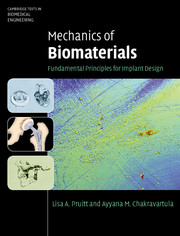Book contents
- Frontmatter
- Contents
- Symbols
- Prologue
- Part I Materials
- 1 Biocompatibility, sterilization, and materials selection for implant design
- 2 Metals for medical implants
- 3 Ceramics
- 4 Polymers
- 5 Mechanical behavior of structural tissues
- Part II Mechanics
- Part III Case studies
- Epilogue
- Appendix A Selected topics from mechanics of materials
- Appendix B Table of material properties of engineering biomaterials and tissues
- Appendix C Teaching methodologies in biomaterials
- Glossary
- Index
- References
3 - Ceramics
from Part I - Materials
Published online by Cambridge University Press: 05 June 2012
- Frontmatter
- Contents
- Symbols
- Prologue
- Part I Materials
- 1 Biocompatibility, sterilization, and materials selection for implant design
- 2 Metals for medical implants
- 3 Ceramics
- 4 Polymers
- 5 Mechanical behavior of structural tissues
- Part II Mechanics
- Part III Case studies
- Epilogue
- Appendix A Selected topics from mechanics of materials
- Appendix B Table of material properties of engineering biomaterials and tissues
- Appendix C Teaching methodologies in biomaterials
- Glossary
- Index
- References
Summary
Inquiry
How would you create a bone graft for the supporting structure of a dental implant if the patient has periodontal disease accompanied by bone loss in the jaw and also suffers from osteoporosis (porous bone)?
The above inquiry presents a realistic challenge that one might face in the field of dentistry. A dental implant must be integrated into the underlying bone in order to have the necessary structural support needed for function. A patient who has periodontal disease accompanied by bone loss in the jaw and who also suffers from osteoporosis (porous bone) is unlikely to have bone tissue that can be used as a structural graft. Traditionally bone grafts are obtained from elsewhere in the patient's body such as ribs, pelvis, or skull. If the patient has had severe trauma or other disease such as osteoporosis, there may be insufficient quantity or quality of bone available. In such cases, viable alternatives such as coral may be necessary. The case study presented at the end of this chapter examines coral as a bone substitute.
Historical perspective and overview
Structural materials, such as plaster of Paris (loosely categorized as a resorbable ceramic), were first employed as a bone substitute in the late 1800s (Pelter, 1959). Even today this material is used as a structural support for fractured bones. Plaster of Paris, which is made of calcium sulphate hemihydrate (CaSO4·H2O), is also used in radiotherapy to make immobilization casts for patients and in dentistry for modeling of oral tissues. Only within the last 50 years have medical ceramics been incorporated into load-bearing applications. The use of ceramics in structural applications has been restricted due to their inherent susceptibility to fracture and sensitivity to flaws (Kingery, 1976). For this reason, ceramics have had limited use in medical implants in which any tensile stresses were expected. Modern manufacturing methods, including sintering and high-pressure compaction, have enabled these materials to be produced with fewer defects and better mechanical properties. As a result of such technological development, ceramics are now utilized in a variety of applications including heart valves (More and Silver, 1990), bone substitutes (Bajpai, 1990), dental implants (Hulbert et al., 1987), femoral heads (Oonishi, 1992), middle ear ossicles (Grote, 1987), and bone screws (Zimmermann et al., 1991). Additionally, ceramics can be utilized in inert, active, and resorbable forms.
- Type
- Chapter
- Information
- Mechanics of BiomaterialsFundamental Principles for Implant Design, pp. 70 - 91Publisher: Cambridge University PressPrint publication year: 2011



